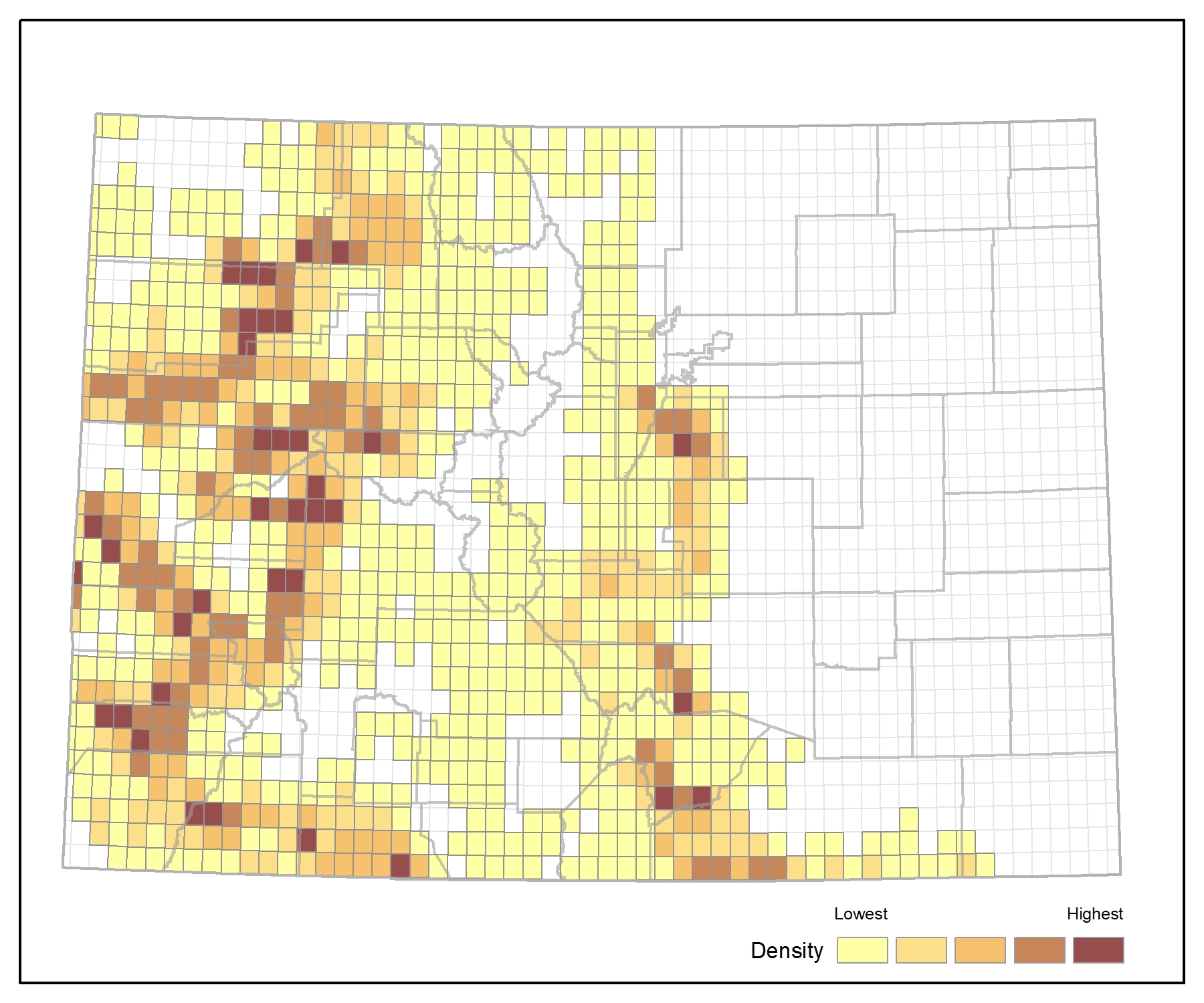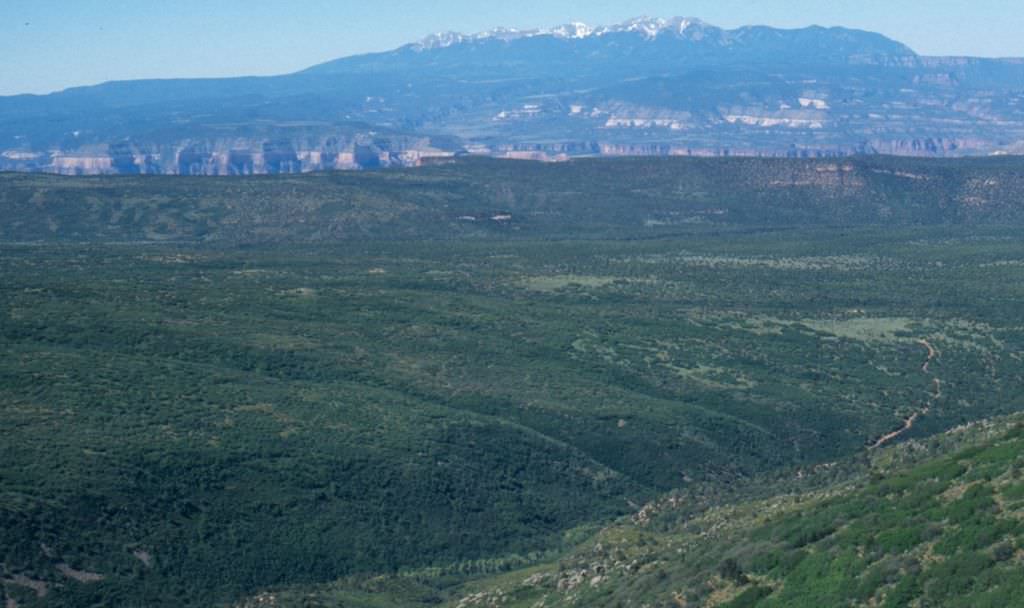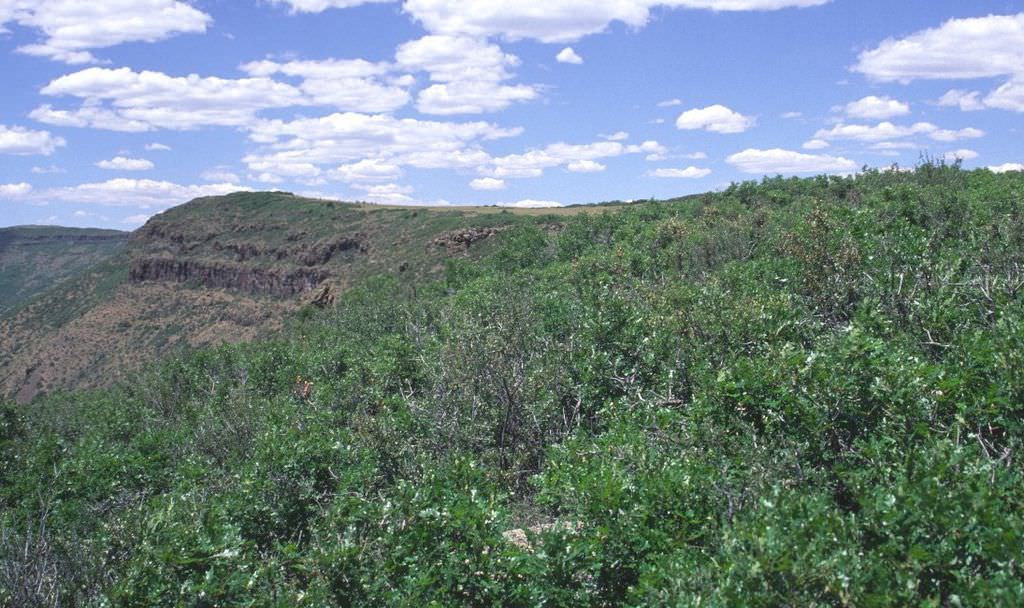Rocky Mountain Gambel Oak-Mixed Montane Shrubland
Click link below for details.
General Description
This ecological system occurs in the mountains, plateaus, and foothills in the southern Rocky Mountains and Colorado Plateau ecoregions. In Colorado these shrublands are most commonly found along dry foothills and lower mountain slopes of western Colorado, and at the mountain front edge of the western Great Plains from approximately 1,830 to 2,750 m (6,000-9,000 ft) in elevation, and are often located above pinyon-juniper woodlands. Vegetation may be dominated by Gambel oak (Quercus gambelii) either alone, or with serviceberry (Amelanchier alnifolia or A. utahensis), big sagebrush (Artemisia tridentata), mountain mahogany (Cercocarpus spp.), bitterbrush (Purshia spp.) or snowberry (Symphoricarpos spp). In some places stands of montane shrublands dominated by these and other species are intermingled and Gambel oak is absent or a minor component. This ecological system intergrades with the lower montane-foothills shrubland system and shares many of the same site characteristics. Although this is a shrub-dominated system, some trees may be present. In well-developed sites, some of the shrubs may grow to tree-like sizes. Adjacent communities often include mixed conifer forests, aspen forests at higher elevations, and pinyon-juniper woodlands at lower elevations. Sagebrush shrubland or steppe, and montane to foothills grasslands may also be part of the adjacent landscape.
Diagnostic Characteristics
These are mixed-species shrublands characterized by taller shrubs. Gambel oak is usually dominant, but some areas may be dominated by other shrubs including serviceberry, big sagebrush, mountain mahogany, or other mesic montane species.
Similar Systems
Range
Rocky Mountain Gambel oak-Mixed Montane shrublands occur in the mountains, plateaus, and foothills in the southern Rocky Mountains and Colorado Plateau ecoregions, including the Uinta and Wasatch ranges and the Mogollon Rim. It also extends into the high mountains of the Trans-Pecos of Texas. Oak and mixed mountain shrublands are widespread in the western half of Colorado, and along the southern stretch of the eastern mountain front.
Ecological System Distribution

Spatial Pattern
Rocky Mountain Gambel Oak-Mixed Montane Shrubland is a large patch type.
Environment
This ecological system typically occupies the lower slope positions of the foothill and lower montane zones where it may occur on level to steep slopes, cliffs, escarpments, rimrock slopes, rocky outcrops, and scree slopes. Climate is semi-arid and characterized by mostly hot-dry summers with mild to cold winters and annual precipitation of 25-70 cm in (10-27). Precipitation mostly occurs as winter snows but may also consist of some late summer rains. Substrates are variable and include soil types ranging from calcareous, heavy, fine-grained loams to sandy loams, gravelly loams, clay loams, deep alluvial sand, or coarse gravel. Soils are typically poorly developed, rocky to very rocky, and well-drained. Parent materials include alluvium, colluvium, and residuum derived from igneous, metamorphic, or sedimentary rocks such as granite, gneiss, limestone, quartz, monzonite, rhyolite, sandstone, schist, and shale.
In general, the upper and lower elevational limits of Gambel oak shrublands are believed to be controlled by temperature and moisture stress. At more northern latitudes, the zone of tolerable cold stress is found at lower elevations, but, at the same time, the areas where summer moisture stress is tolerable are at higher elevations. The northern distributional limit of Gambel oak corresponds to the point where these two opposing factors converge.
Vegetation
Stands dominated by Gambel oak are common in the southern part of Colorado, but are completely interspersed with stands dominated by other shrub species, especially serviceberry (Amelanchier spp.) and mahogany (Cercocarpus spp.) at higher elevations. The vegetation is typically dominated by Gambel oak alone or codominant with Saskatoon serviceberry (Amelanchier alnifolia), Utah serviceberry (Amelanchier utahensis), big sagegrush (Artemisia tridentata), mountain mahogany (Cercocarpus montanus), chokecherry (Prunus virginiana), Stansbury cliffrose (Purshia stansburiana), antelope bitterbrush (Purshia tridentata), mountain snowberry (Symphoricarpos oreophilus), or roundleaf snowberry (Symphoricarpos rotundifolius). Vegetation types in this system may occur as sparse to dense shrublands composed of mid to tall shrubs. Occurrences may be multi-layered, with some short shrubby species occurring in the understory of the dominant overstory species. Occurrences can range from dense thickets with little understory to relatively mesic mixed-shrublands with a rich understory of shrubs, grasses and forbs. These shrubs often have a patchy distribution with grass growing in between. Scattered trees are occasionally present in stands and typically include species of pine or juniper. Annual grasses and forbs are seasonally present, and weedy annuals are often present, at least seasonally.
Non-oak dominated montane shrublands are of variable species composition, depending on site conditions such as elevation, slope, aspect, soil type, moisture availability, and past history. Species present may include mountain mahogany (Cercocarpus montanus), skunkbush sumac (Rhus trilobata), cliff fendlerbush (Fendlera rupicola), antelope bitterbrush (Purshia tridentata), wild crab apple (Peraphyllum ramosissimum), snowberry (Symphoricarpos spp.), and serviceberry (Amelanchier spp.).
- CEGL002569 Amelanchier alnifolia / Symphoricarpos oreophilus Shrubland
- CEGL003817 Amelanchier utahensis - Fendlera rupicola Shrubland
- CEGL001068 Amelanchier utahensis - Mixed Shrub / Carex geyeri Shrubland
- CEGL001069 Amelanchier utahensis / Pseudoroegneria spicata Shrubland
- CEGL001067 Amelanchier utahensis Shrubland
- CEGL002696 Arctostaphylos patula Shrubland
- CEGL002783 Jamesia americana - (Physocarpus monogynus, Holodiscus dumosus) Rock Outcrop Shrubland
- CEGL002967 Juniperus scopulorum - Quercus gambelii Woodland
- CEGL001113 Quercus gambelii - Cercocarpus montanus / (Carex geyeri) Shrubland
- CEGL002341 Quercus gambelii - Holodiscus dumosus Shrubland
- CEGL001109 Quercus gambelii / Amelanchier alnifolia Shrubland
- CEGL001110 Quercus gambelii / Amelanchier utahensis Shrubland
- CEGL001111 Quercus gambelii / Artemisia tridentata Shrubland
- CEGL005995 Quercus gambelii / Carex geyeri Shrubland
- CEGL001112 Quercus gambelii / Carex inops ssp. heliophila Shrubland
- CEGL002805 Quercus gambelii / Festuca thurberi Shrubland
- CEGL002915 Quercus gambelii / Hesperostipa comata Shrubland
- CEGL001114 Quercus gambelii / Paxistima myrsinites Shrubland
- CEGL002949 Quercus gambelii / Poa fendleriana Shrubland
- CEGL005994 Quercus gambelii / Prunus virginiana Shrubland
- CEGL002338 Quercus gambelii / Rhus trilobata Shrubland
- CEGL002337 Quercus gambelii / Sparse Understory Shrubland
- CEGL001117 Quercus gambelii / Symphoricarpos oreophilus Shrubland
- CEGL002477 Quercus gambelii Shrubland
Associated Animal Species
Oak and mixed mountain shrublands are important habitat for mule deer (Odocoileus hemionus) and black bear (Ursus americanus). Other mammals found in this habitat include elk (Cervus elaphus), mountain lion (Felis concolor), bobcat (Felis rufus), coyote (Canis latrans), skunk (Family Mephitidae), poucupine (Erethizon dorsatum), Abert's squirrel (Sciurus aberti), rock squirrel (Otospermophilus variegatus), chipmunks (Neotamias spp.), and Mexican woodrat (Neotoma mexicana). Bird species include Wild Turkey (Meleagris gallopavo), Virginia's Warbler (Oreothlypis virginiae), Green-tailed Towhee (Pipilo chlorurus), Spotted Towhee (Pipilo maculatus), Dusky Flycatcher (Empidonax oberholseri), Woodhouse's Scrub-Jay (Aphelocoma woodhouseii), Blue-gray Gnatcatcher (Polioptila caerulea), Black-headed Grosbeak (Pheucticus melanocephalus), Orange-crowned Warbler (Oreothlypis celata), and Broad-tailed Hummingbird (Selasphorus platycercus).
Dynamic Processes
The shrub growth form of the dominant species, and ability to quickly colonize new areas make this system highly resilient to disturbance, and tolerant of fire. Fire causes die-back of the dominant shrub species in some areas, promotes stump sprouting of the dominant shrubs in other areas, and controls the invasion of trees into the shrubland system. Density and cover of Gambel oak and serviceberry often increase after fire. Gambel oak reproduces primarily by sprouting of new stems, especially after disturbances such as brush control, fire, and grazing, although recruitment from seedlings does occur. The extensive clonal root system of Gambel oak is a primary contributor to its ability to survive during periods when seedling establishment is impossible. Most of the other shrub species reproduce both vegetatively and by seedling recruitment, as well as resprouting easily after fire. Natural fires typically result in a system with a mosaic of dense shrub clusters and openings dominated by herbaceous species. Variable disturbance patterns may account for the local dominance of a particular species.
Management
Because oak is generally unpalatable to cattle, livestock grazing can facilitate the increase of oak cover at the expense of understory grasses. Livestock grazing has degraded the understory grass community of some oak stands, and cheatgrass and knapweed have become established in some areas. Mixed mountain shrublands are generally less impacted by invasives.
Oak shrublands are most vulnerable to drought and variability of late frosts. The vulnerability of other mountain shrub species is not well known. The ability to resprout after disturbance increases shrub resilience. Oak and mixed mountain shrublands have comparatively low vulnerability to the effects of climate change by mid-century. Primary vulnerability-reducing factors are the wide ecological amplitude of these shrublands in Colorado, and their ability to withstand or recover from disturbance relatively quickly, which offsets the lower landscape condition score due to past anthropogenic disturbance levels.
References
- Brown, H.E. 1958. Gambel oak in west-central Colorado. Ecology 39:317-327.
- Christensen, E. M. 1949. The ecology and geographic distribution of oak (Quercus gamvelii) in Utah. Unpublished thesis, University of Utah, Salt Lake City. 70 pp.
- Harper, K.T., F.J. Wagstaff, and L.M. Kunzler. 1985. Biology management of the Gambel oak vegetative type: a literature review. Gen. Tech. Rep. INT-179. Department of Agriculture, Forest Service, Intermountain Forest and Range Experiment Station. Ogden, Utah.
- Jester, N., K. Rogers, and F.C. Dennis. 2012. Gambel oak management. Natural Resources Series-Forestry Fact Sheet No. 6.311. Colorado State University Extension, Fort Collins, Colorado.
- Keeley, J.E. 2000. Chaparral. Chapter 6 in North American Terrestrial Vegetation, second edition. M.G. Barbour and W.D. Billings, eds. Cambridge University Press.
- Neilson, R.P. and L.H. Wullstein. 1983. Biogeography of two southwest American oaks in relation to atmospheric dynamics. Journal of Biogeography 10:275-297.
- Rondeau, R.J. 2001. Ecological system viability specifications for Southern Rocky Mountain ecoregion. First Edition. Colorado Natural Heritage Program, Colorado State University, Fort Collins, CO. 181 pp.









